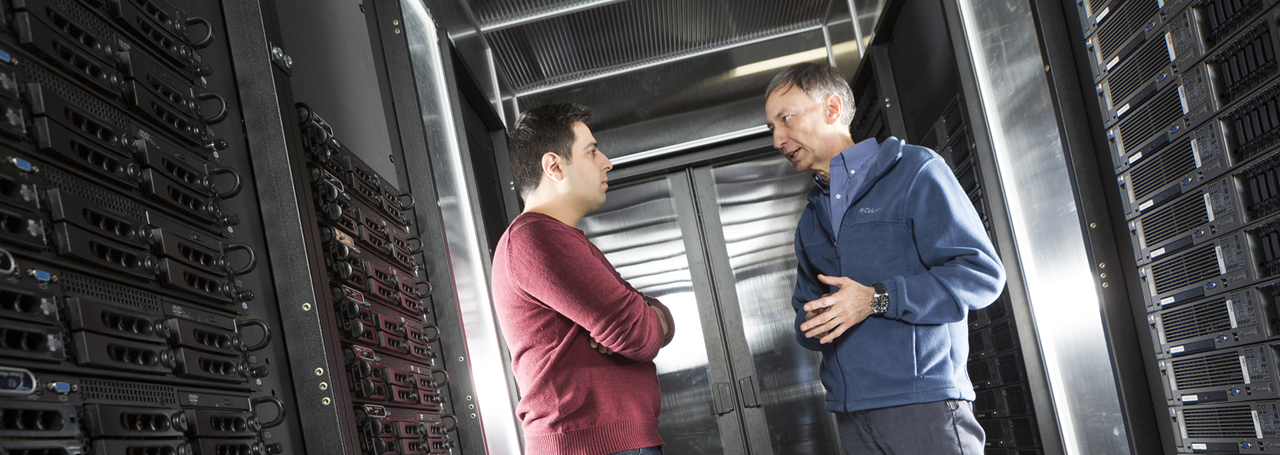Binghamton’s ES2 leads efforts to maximize data center efficiency
For scientists at Binghamton University’s Center for Energy-Smart Electronic Systems (ES2), the issue is clear: Big data keeps getting bigger. Every year, data centers across the United States consume 100 billion kilowatt hours of energy, nearly 3 percent of the total electricity used nationwide. It’s a rapidly expanding, energy-intensive industry, and even with ongoing improvements in efficiency, there’s an enormous amount of power being wasted.
“We think we can save close to one-third of the energy used at data centers,” says Bahgat Sammakia, vice president for research at Binghamton and director of ES2, a National Science Foundation Industry/University Cooperative Research Center (I/UCRC). “Given how much energy is being consumed, that’s a huge number, which makes this a really complex problem. To do this job correctly, we need to focus on smart design, smart usage, and total optimization. We need to approach the problem in a holistic fashion that looks at the thermal implications, the IT implications, and the implications on the user experience.”
Founded in 2011 by Binghamton, the Georgia Institute of Technology, the University of Texas at Arlington, Villanova University and more than a dozen corporate partners – including Bloomberg, Facebook, IBM, Microsoft and Verizon – ES2 has been growing steadily ever since. The center has more than two dozen industry partners, which provide much of its funding, help design research projects, mentor students and offer internships.
In the past year, ES2 announced its first international academic partner, Vishwakarma Institute of Technology, to extend the benefits of ES2 research to India, which is also in the midst of a surge of data center growth. In another recent development, ES2 was awarded a $1.2M NSF grant to investigate the possibility of powering data centers with a hybrid of AC and DC power, which will provide further reduction in energy consumption.
“There is a huge amount of inefficiency in the way most data centers are currently managed,” says Binghamton site director Kanad Ghose, who is also chair of Binghamton’s department of computer science. To manage the peaks of user demands, operators keep their servers running even during times of minimal use; then to compensate, they spend between a third and half of their energy on keeping the machines cool.
“What we need,” he says, “is a system to track the load as it varies over minutes or seconds, and to respond without overprovisioning either the IT capacity or the cooling. We need to develop data centers that are smart enough to self-measure and self-regulate, so that they perform at an optimal level while reducing energy consumption. That encompasses a lot of complex science, and therein lies the challenge.”
To meet that challenge, Binghamton has a new, fully instrumented 4,500-square-foot data center with four cold aisles, three types of cooling technologies, more than 50 racks of IT equipment and an extensive system of optical fiber-based connections and load-balancing switches. Housed in Binghamton’s new Center of Excellence Building, it’s built to perform all the tasks of a mid-range center, but with one important difference: It’s a laboratory.
In experiments on capacity, the lab has controls in hardware and software to measure power consumption, server loads and real-time network traffic, with the ability to model state-of-the-art data centers and the older, legacy centers that are commonly used around the country. In experiments on cooling, there are instruments to adjust air velocities, water flow, computer room air conditioning (CRAC), inlet temperatures and the mix of cold and warm water, with infrared imagery and air-flow visualization tools to assess hotspots.
In all, there are 14 current research projects at the four partner universities, with more than 30 students gaining experience solving problems of critical importance to industry. “There’s a great benefit for the students involved,” says Andrea Palmeri, ES2 managing director. “They’re doing research that’s very, very relevant and getting a feel for what it’s like to be closely engaged with industry. Twice a year, we bring all our university colleagues and industrial partners together for face-to-face meetings, where students formally present their progress on each project through presentations and poster sessions. That gives students the opportunity to do a deep dive on their research, and a number of them have gone on to be hired by our partners.”
“We get the funding to support our research,” Sammakia adds. “Industry gets their problem solved. And students get a great introduction to our industrial partners. It’s a win-win situation for all of us.”
comments powered by Disqus


